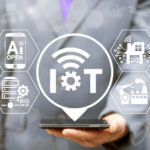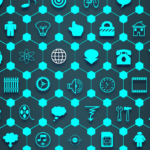Technologies that take advantage of the Internet of Things are currently widely used. We’re in the era of the “Internet of Things,” or IoT. Connected devices are everywhere, from the smartwatch on your wrist to the massive industries worldwide. Having technology that facilitates our needs is no longer the stuff of science fiction.
It is important to know that there is no universal and agreed-upon IoT architecture. The complexity and quantity of architectural levels vary depending on a particular business task.
The IoT architecture is broken down into its components in this article. Let’s take a look to see how it works.
What Is IoT Architecture?
An IoT architecture is a complex cyber-digital system comprising interoperating hardware and software components. These parts work together to provide the framework of an IoT solution.
To set the record straight before we delve into the specifics, there is no cookie-cutter method for developing an IoT infrastructure. Nonetheless, regardless of the answer, the fundamental structure remains unchanged.
A Standard IoT Architecture
The basic IoT architecture consists of five layers, as described below and is used by most data-driven IoT applications.
Perception/Device layer
Any electronic or non-electronic object equipped with a camera, sensor, and actuator can be classified as a part of the device layer.
The information from the physical environment is collected by sensors and transformed into electrical impulses for further processing by a computer. Sensors in the Internet of Things come in a wide range of sizes and serve a variety. They can record all sorts of data, including temperature, motion, humidity, etc.
In turn, actuators cause networked devices to carry out the instructions issued by the brain. When given instructions, an actuator causes a machine to act in a predetermined fashion. An example of an intelligent lighting system activates the lights when motion is sensed.
Connectivity/Network Layer
The network layer of the IoT architecture is responsible for bridging the gap between the device layer and the following levels. Some IoT solutions may enable direct device connectivity, whereas others use gateways. The latter is typical for incompatible protocols or older equipment that cannot be linked directly.
The following forms of data transmission are essential to the operation of today’s Internet of Things solutions:
LPWANs enable large-scale IoT installations. LPWANs enable long-distance communication without compromising efficiency, durability, or cost. Smart buildings and industrial IoT are ideal use cases for low-power wide-area networks (LPWANs) because they can only send a modest quantity of data at a slow rate.
Zigbee. Zigbee excels at short-range wireless communication for medium-range Internet of Things applications like smart dwellings. Zigbee has higher data rates than LPWAN but uses more energy.
Cellular networks offer:
- Reliable broadband.
- They’re perfect for linked car use cases.
- Transport.
- Logistics.
- Autopilot.
Cellular networks are expensive and incompatible with battery-powered sensor networks, limiting their use.
Bluetooth is appropriate for short-range wireless networking in consumer IoT devices like fitness trackers, medical monitoring systems, and home IoT appliances.
Wi-Fi speeds data transport. It works well with wall-plugged intelligent gadgets including smart houses, security systems, and digital billboards.
RFID. RFID tags may exchange modest quantities of data with neighbouring readers using radio waves. Transportation and retail use this communication system extensively.
Edge Computing Layer
The edge processing layer is spread throughout the network, gateways, local servers, and other edge nodes. The goal of implementing edge devices is to reduce the amount of data being transferred to the cloud by storing and processing it closer to its point of origin and only transmitting a subset of the created records there.
Data processing was not the only thing the edge layer could do; it could filter, collect, and encrypt incoming data.
The time and energy spent uploading all the created records to the cloud are avoided when data is processed locally. As a result, lower latency and increased efficiency are the outcomes.
For example, in medical IoT systems, CCTV systems, or smart cars, adding an edge layer is a realistic choice for data analysis in real-time, built-in scalability, and increased security.
Processing Layer
Most information gathered by IoT gadgets is stored here. Data collection, processing, and storage thus occur at the processing layer. In this layer, the following two crucial steps appear:
Data accumulation
IoT systems produce massive amounts of data, not all of which are instantly actionable. As a result, a data lake might be part of an IoT architecture to collect and store all the data generated before sending only the filtered and cleaned records farther along the data management pipeline.
This phase is to consolidate all of the information, determine whether or not every given piece of data is necessary for the operation of the business, and then decide whether or not to store it in a temporal database or a permanent data warehouse.
Data abstraction
At this point, data from relevant external sources is added to the information gathered by IoT devices. Enterprise resource planning systems, electronic medical record systems, and similar systems could fall under this category.
After being standardised, the information is stored in a single location, such as a data warehouse, from which it can be quickly retrieved to support decision-making.
Application Layer
Data from IoT devices and other sources is collected, processed, and integrated before being fed into analytics algorithms and displayed to end users at the application layer.
The business needs for an IoT system determine the types of applications needed. Examples include business intelligence tools, sophisticated analytics solutions using machine learning and artificial intelligence, web or mobile applications that give visualised insights to end users, and actuators used to manage IoT devices.
Final Thoughts
If you’re set on using IoT, you should start planning the architecture of your future solution right away. A poorly-architected system would not be able to handle the complexity or grow with demand. A well-designed IoT architecture would prepare you for the future and assure maintainability, scalability, cost-efficiency, and interoperability.








